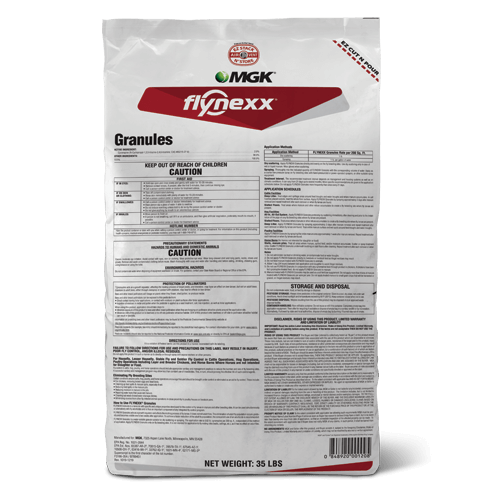Features & Benefits
- For control of fly larvae in and around livestock facilities
- Water-soluble granule suitable for dry scattering or spraying to manure and other fly breeding sources
- Can be used simultaneously with adulticides as an important component of an integrated fly control program
- Can be used in tandem with beneficial wasps
Flynexx® Sell Sheet
Find product features, key benefits and performance data detailed in the Flynexx sell sheet.
Pest Control Protocol: Flies in Egg Laying Facilities
A comprehensive protocol to help poultry producers stay in control of flies. Includes: pest identification, common species, hot spots, inspection, treatment and fly control product information.
Spanish Pest Control Protocol: Fly Control in Egg Laying Facilities
Spanish language version of MGK’s comprehensive protocol to help producers stay in control of flies in poultry facilities. Includes: insect identification, common species, hot spots, inspection, treatment and control product information.
Pest Control Protocol: Flies in Dairy & Confined Livestock Facilities
A comprehensive protocol to help producers stay in control of flies in dairies and confined livestock facilities. Includes: pest identification, common species, hot spots, inspection, treatment and fly control product information.
Spanish Pest Control Protocol: Flies in Dairy & Confined Livestock Facilities
Spanish language version of MGK’s comprehensive protocol to help producers stay in control of flies in dairies and confined livestock facilities. Includes: pest identification, common species, hot spots, inspection, treatment and fly control product information.
Pest Control Protocol: House Flies in Poultry Facilities
MGK’s comprehensive protocol to help producers stay in control of house flies in poultry facilities. Includes: insect identification, common species, hot spots, inspection, treatment and control product information.
Spanish Pest Control Protocol: House Flies in Poultry Facilities
Spanish language version of MGK’s comprehensive protocol to help producers stay in control of house flies in poultry facilities. Includes: insect identification, common species, hot spots, inspection, treatment and control product information.
Flynexx® FAQs
Flynexx® is available in a 35 pound bag. Please contact your distributor for availability.
You can reapply as frequently as 21 days.
Allow one day between the last application and slaughter to avoid illegal residues.
As an insect growth regulator (IGR), Flynexx® should be applied in areas of fly breeding and development. Examples include manure sites, pit systems, litter storage, stalls and other areas of organic matter accumulation.
Flynexx® may be used as either a granular application or diluted in water. When applied to liquid or moist substrates, such as manure pits, scattering Flynexx® granules is recommended. When applied to drier substrates, such as soil or sand beds, Flynexx® will be more readily absorbed if it is sprayed on the area with a water-based solution.
Flynexx® is a dipteran molting disruptor which means that it keeps immature flies from growing into adult insects. Flies will die before reaching the pupal stage because they are unable to form a pupa casing. By keeping flies in the soft-bodied immature stage, they are easier to kill because immature flies, or maggots, are less mobile and lack an exoskeleton. The absence of an exoskeleton allows the insecticide to penetrate faster and their restricted mobility helps the user target applications to areas of fly development.
Flynexx® is a supplemental form of fly control and compliments applications of insecticides and biological controls like parasitic wasps.
Because of its mode of action, Flynexx® is very specific to which insect it is effective against. Currently, Flynexx® is only labeled for the control of filth flies.

